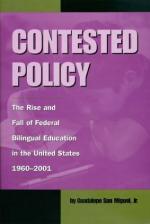|
This section contains 884 words (approx. 3 pages at 300 words per page) |

|
Bilingual education developed into a particularly contentious topic for defining American identity in the twentieth century. While federal legislation since the 1960s has recognized the United States as a multilingual nation, the professed long-range goal of institutionalized bilingual education was not that students should achieve bilingualism but proficiency in English. The vast majority of bilingual education programs were considered "transitional," functioning to introduce younger students with limited English-speaking ability into the general education curriculum where English served historically as the language of instruction. Many bilingual programs were taught principally either in English or in the primary language of the student. However, by the end of the twentieth century, federally funded programs had begun to favor instruction in both English and the primary language, an apparent departure from the goal of achieving proficiency in a single language.
The country's continued difficulty through the late twentieth century in...
|
This section contains 884 words (approx. 3 pages at 300 words per page) |

|


